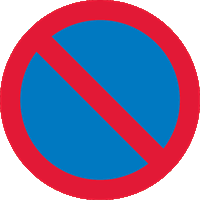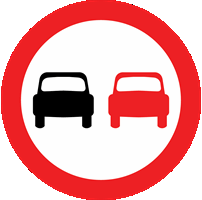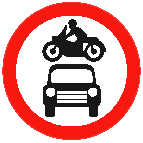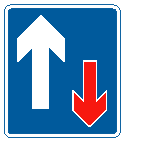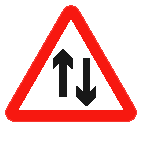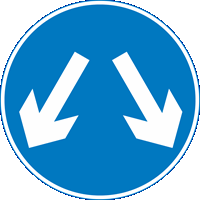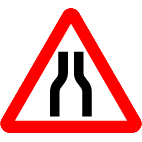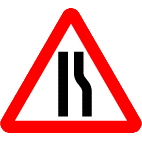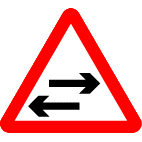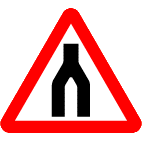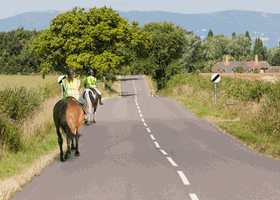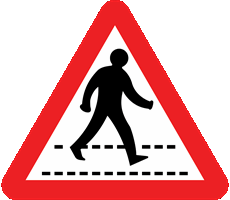You have 57 minutes to answer 50 multiple choice theory test questions. You need to answer at least 43 out of 50 questions correctly to pass. You can review your answer after each question or you can review all of your answers at the end of the test. Best of luck!
Test Quick View
Click on an answer to view the correct choice along with the explanation.
1. Which THREE of these emergency services might have blue flashing beacons?
Mark three answers
B
C
D
E
F
Correct Answer: B, C, F
Explanation: When attending an emergency these vehicles will be travelling at speed. You should help their progress by pulling over and allowing them to pass. Do so safely. Don't stop suddenly or in a dangerous position.
Explanation: When attending an emergency these vehicles will be travelling at speed. You should help their progress by pulling over and allowing them to pass. Do so safely. Don't stop suddenly or in a dangerous position.
Correct Answer: A
Explanation: If you see a vehicle with a flashing green beacon approaching, allow it to pass when you can do so safely. Be aware that someone's life could depend on the driver making good progress through traffic.
Explanation: If you see a vehicle with a flashing green beacon approaching, allow it to pass when you can do so safely. Be aware that someone's life could depend on the driver making good progress through traffic.
Correct Answer: D
Explanation: These signs only apply to trams. They are directed at tram drivers but you should know their meaning so that you're aware of the priorities and are able to anticipate the actions of the driver.
Explanation: These signs only apply to trams. They are directed at tram drivers but you should know their meaning so that you're aware of the priorities and are able to anticipate the actions of the driver.
4. You intend to turn right into a side road. Just before turning you should check for motorcyclists who might be
Mark one answer
B
C
D
Correct Answer: D
Explanation: Never attempt to change direction to the right without first checking your right-hand mirror. A motorcyclist might not have seen your signal and could be hidden by the car behind you. This action should become a matter of routine.
Explanation: Never attempt to change direction to the right without first checking your right-hand mirror. A motorcyclist might not have seen your signal and could be hidden by the car behind you. This action should become a matter of routine.
5. You are travelling in very heavy rain. Your overall stopping distance is likely to be
Mark one answer
B
C
D
Correct Answer: A
Explanation: As well as visibility being reduced, the road will be extremely wet. This will reduce the grip the tyres have on the road and increase the distance it takes to stop. Double your separation distance.
Explanation: As well as visibility being reduced, the road will be extremely wet. This will reduce the grip the tyres have on the road and increase the distance it takes to stop. Double your separation distance.
Correct Answer: D
Explanation: This sign indicates that there are waiting restrictions. It is normally accompanied by details of when restrictions are in force. Details of most signs which are in common use are shown in The Highway Code and a more comprehensive selection is available in Know Your Traffic Signs.
Explanation: This sign indicates that there are waiting restrictions. It is normally accompanied by details of when restrictions are in force. Details of most signs which are in common use are shown in The Highway Code and a more comprehensive selection is available in Know Your Traffic Signs.
Correct Answer: B
Explanation: Road signs that prohibit overtaking are placed in locations where passing the vehicle in front is dangerous. If you see this sign don't attempt to overtake. The sign is there for a reason and you must obey it.
Explanation: Road signs that prohibit overtaking are placed in locations where passing the vehicle in front is dangerous. If you see this sign don't attempt to overtake. The sign is there for a reason and you must obey it.
Correct Answer: B
Explanation: This sign indicates that overtaking here is not allowed and you could face prosecution if you ignore this prohibition.
Explanation: This sign indicates that overtaking here is not allowed and you could face prosecution if you ignore this prohibition.
Correct Answer: C
Explanation: These signs are often seen in one-way streets that have more than one lane. When you see this sign, use the route that's the most convenient and doesn't require a late change of direction.
Explanation: These signs are often seen in one-way streets that have more than one lane. When you see this sign, use the route that's the most convenient and doesn't require a late change of direction.
Correct Answer: D
Explanation: If you're overtaking make sure you move back safely into the left-hand lane before you reach the end of the dual carriageway.
Explanation: If you're overtaking make sure you move back safely into the left-hand lane before you reach the end of the dual carriageway.
Correct Answer: C
Explanation: You should move into the lanes as directed by the sign. Here the right-hand lane is closed and the left-hand and centre lanes are available. Merging in turn is recommended when it's safe and traffic is going slowly, for example at road works or a road traffic incident. When vehicles are travelling at speed this is not advisable and you should move into the appropriate lane in good time.
Explanation: You should move into the lanes as directed by the sign. Here the right-hand lane is closed and the left-hand and centre lanes are available. Merging in turn is recommended when it's safe and traffic is going slowly, for example at road works or a road traffic incident. When vehicles are travelling at speed this is not advisable and you should move into the appropriate lane in good time.
Correct Answer: C
Explanation: It is important to know and obey temporary signs on the motorway: they are there for a reason. You may not be able to see the hazard straight away, as the signs give warnings well in advance, due to the speed of traffic on the motorway.
Explanation: It is important to know and obey temporary signs on the motorway: they are there for a reason. You may not be able to see the hazard straight away, as the signs give warnings well in advance, due to the speed of traffic on the motorway.
Correct Answer: B
Explanation: At night or in poor visibility reflective studs on the road help you to judge your position on the carriageway.
Explanation: At night or in poor visibility reflective studs on the road help you to judge your position on the carriageway.
14. You are intending to turn right at a crossroads. An oncoming driver is also turning right. It will normally be safer to
Mark one answer
B
C
D
Correct Answer: D
Explanation: At some junctions the layout may make it difficult to turn offside to offside. If this is the case, be prepared to pass nearside to nearside, but take extra care as your view ahead will be obscured by the vehicle turning in front of you.
Explanation: At some junctions the layout may make it difficult to turn offside to offside. If this is the case, be prepared to pass nearside to nearside, but take extra care as your view ahead will be obscured by the vehicle turning in front of you.
15. You are travelling at the legal speed limit. A vehicle comes up quickly behind, flashing its headlights. You should
Mark one answer
B
C
D
Correct Answer: B
Explanation: Don't enforce the speed limit by blocking another vehicle's progress. This will only lead to the other driver becoming more frustrated. Allow the other vehicle to pass when you can do so safely.
Explanation: Don't enforce the speed limit by blocking another vehicle's progress. This will only lead to the other driver becoming more frustrated. Allow the other vehicle to pass when you can do so safely.
Correct Answer: A
Explanation: Don't park within 10 metres (32 feet) of a junction (unless in an authorised parking place). This is to allow drivers emerging from, or turning into, the junction a clear view of the road they are joining. It also allows them to see hazards such as pedestrians or cyclists at the junction.
Explanation: Don't park within 10 metres (32 feet) of a junction (unless in an authorised parking place). This is to allow drivers emerging from, or turning into, the junction a clear view of the road they are joining. It also allows them to see hazards such as pedestrians or cyclists at the junction.
Correct Answer: B
Explanation: Some modern batteries are maintenance-free. Check your vehicle handbook and, if necessary, make sure that the plates in each battery cell are covered
Explanation: Some modern batteries are maintenance-free. Check your vehicle handbook and, if necessary, make sure that the plates in each battery cell are covered
Correct Answer: D
Explanation: Note that this is the typical stopping distance. It will take at least this distance to think, brake and stop in good conditions. In poor conditions it will take much longer.
Explanation: Note that this is the typical stopping distance. It will take at least this distance to think, brake and stop in good conditions. In poor conditions it will take much longer.
Correct Answer: D
Explanation: Be particularly careful when approaching horse riders - slow down and be prepared to stop. Always pass wide and slowly and look out for signals given by horse riders. Horses are unpredictable: always treat them as potential hazards and take great care when passing them.
Explanation: Be particularly careful when approaching horse riders - slow down and be prepared to stop. Always pass wide and slowly and look out for signals given by horse riders. Horses are unpredictable: always treat them as potential hazards and take great care when passing them.
B
C
D
Correct Answer: D
Explanation: Where street repairs have closed off pavements, proceed carefully and slowly as pedestrians might have to walk in the road.
Explanation: Where street repairs have closed off pavements, proceed carefully and slowly as pedestrians might have to walk in the road.
21. You are following a large vehicle approaching crossroads. The driver signals to turn left. What should you do?
Mark one answer
B
C
D
Correct Answer: B
Explanation: Hold back and wait until the vehicle has turned before proceeding. Do not overtake because the vehicle turning left could hide a vehicle emerging from the same junction.
Explanation: Hold back and wait until the vehicle has turned before proceeding. Do not overtake because the vehicle turning left could hide a vehicle emerging from the same junction.
Correct Answer: A
Explanation: Stay in the left-hand lane long enough to get used to the higher speeds of motorway traffic.
Explanation: Stay in the left-hand lane long enough to get used to the higher speeds of motorway traffic.
Correct Answer: C
Explanation: A SORN allows you to keep a vehicle off road and untaxed. SORN will end when the vehicle is taxed, sold or scrapped.
Explanation: A SORN allows you to keep a vehicle off road and untaxed. SORN will end when the vehicle is taxed, sold or scrapped.
24. Who is legally responsible for ensuring that a vehicle registration certificate (V5C) is updated?
Mark one answer
B
C
D
Correct Answer: B
Explanation: It is your legal responsibility to keep the details of your vehicle registration certificate (V5C) up to date. You should tell the licensing authority of any changes. These include your name, address, or vehicle details. If you don't do this you may have problems when you sell your vehicle.
Explanation: It is your legal responsibility to keep the details of your vehicle registration certificate (V5C) up to date. You should tell the licensing authority of any changes. These include your name, address, or vehicle details. If you don't do this you may have problems when you sell your vehicle.
25. You are approaching this roundabout and see the cyclist signal right. Why is the cyclist keeping to the left?
Mark one answer
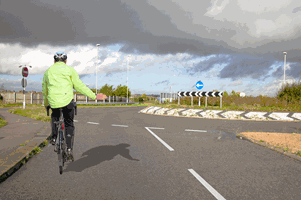
B
C
D
Correct Answer: C
Explanation: Cycling in today's heavy traffic can be hazardous. Some cyclists may not feel happy about crossing the path of traffic to take up a position in an outside lane. Be aware of this and understand that, although in the left-hand lane, the cyclist might be turning right.
Explanation: Cycling in today's heavy traffic can be hazardous. Some cyclists may not feel happy about crossing the path of traffic to take up a position in an outside lane. Be aware of this and understand that, although in the left-hand lane, the cyclist might be turning right.
26. At some traffic lights there are advance stop lines and a marked area. What are these for?
Mark one answer
B
C
D
Correct Answer: A
Explanation: You should always stop at the first white line. Avoid going into the marked area which is reserved for cyclists only. However if you have crossed the first white line at the time the signal changes to red you must stop at the second line even if you are in the marked area.
Explanation: You should always stop at the first white line. Avoid going into the marked area which is reserved for cyclists only. However if you have crossed the first white line at the time the signal changes to red you must stop at the second line even if you are in the marked area.
27. A casualty is not breathing normally. Chest compressions should be given. At what rate?
Mark one answer
B
C
D
Correct Answer: B
Explanation: If a casualty is not breathing normally chest compressions may be needed to maintain circulation. Place two hands on the centre of the chest and press down hard and fast - around 5-6 centimetres and about twice a second.
Explanation: If a casualty is not breathing normally chest compressions may be needed to maintain circulation. Place two hands on the centre of the chest and press down hard and fast - around 5-6 centimetres and about twice a second.
Correct Answer: D
Explanation: Buses and cycles can travel in this lane. In this case they will flow in the same direction as other traffic. If it's busy they may be passing you on the left, so watch out for them. Times on the sign will show its hours of operation. No times shown, or no sign at all, means it's 24 hours. In some areas other vehicles, such as taxis and motorcycles, are allowed to use bus lanes. The sign will show these.
Explanation: Buses and cycles can travel in this lane. In this case they will flow in the same direction as other traffic. If it's busy they may be passing you on the left, so watch out for them. Times on the sign will show its hours of operation. No times shown, or no sign at all, means it's 24 hours. In some areas other vehicles, such as taxis and motorcycles, are allowed to use bus lanes. The sign will show these.
Correct Answer: C
Explanation: Look well ahead and be ready to stop for any pedestrians crossing, or about to cross, the road. Also check the pavements for anyone who looks like they might step or run into the road.
Explanation: Look well ahead and be ready to stop for any pedestrians crossing, or about to cross, the road. Also check the pavements for anyone who looks like they might step or run into the road.
30. When you are overtaking a cyclist you should leave as much room as you would give to a car. What is the main reason for this?
Mark one answer
B
C
D
Correct Answer: D
Explanation: Before overtaking assess the situation. Look well ahead to see if the cyclist will need to change direction. Be especially aware of the cyclist approaching parked vehicles as they will need to alter course. Do not pass too closely or cut in sharply.
Explanation: Before overtaking assess the situation. Look well ahead to see if the cyclist will need to change direction. Be especially aware of the cyclist approaching parked vehicles as they will need to alter course. Do not pass too closely or cut in sharply.
Correct Answer: D
Explanation: If you know which light is going to show next you can plan your approach accordingly. This can help prevent excessive braking or hesitation at the junction.
Explanation: If you know which light is going to show next you can plan your approach accordingly. This can help prevent excessive braking or hesitation at the junction.
B
C
D
E
Correct Answer: A, E
Explanation: First check for anything that may be in the wound such as glass. If there's nothing in it apply a pad of clean cloth or bandage. Raising the leg will lessen the flow of blood. Don't tie anything tightly round the leg. This will restrict circulation and can result in long-term injury.
Explanation: First check for anything that may be in the wound such as glass. If there's nothing in it apply a pad of clean cloth or bandage. Raising the leg will lessen the flow of blood. Don't tie anything tightly round the leg. This will restrict circulation and can result in long-term injury.
Correct Answer: B
Explanation: If you are carrying anything on a roof rack, make sure that any cover is securely fitted and does not flap about while driving. Aerodynamically designed roof boxes are available which reduce wind resistance and, in turn, fuel consumption.
Explanation: If you are carrying anything on a roof rack, make sure that any cover is securely fitted and does not flap about while driving. Aerodynamically designed roof boxes are available which reduce wind resistance and, in turn, fuel consumption.
34. You are reversing around a corner when you notice a pedestrian walking behind you. What should you do?
Mark one answer
B
C
D
Correct Answer: D
Explanation: Wait until the pedestrian has passed, then look around again before you start to reverse. Don't forget that you may not be able to see a small child directly behind your vehicle. Be aware of the possibility of hidden dangers.
Explanation: Wait until the pedestrian has passed, then look around again before you start to reverse. Don't forget that you may not be able to see a small child directly behind your vehicle. Be aware of the possibility of hidden dangers.
Correct Answer: C
Explanation: Before you drive on the road you MUST have a valid provisional licence, for the category of vehicle that you're driving. It must show your signature, it isn't valid without it.
Explanation: Before you drive on the road you MUST have a valid provisional licence, for the category of vehicle that you're driving. It must show your signature, it isn't valid without it.
Correct Answer: D
Explanation: It is illegal to use a hand-held mobile phone while driving, except in a genuine emergency. Even using hands-free kit can distract your attention. Park in a safe and convenient place before receiving or making a call or using text messaging. Then you will also be free to take notes or refer to papers.
Explanation: It is illegal to use a hand-held mobile phone while driving, except in a genuine emergency. Even using hands-free kit can distract your attention. Park in a safe and convenient place before receiving or making a call or using text messaging. Then you will also be free to take notes or refer to papers.
Correct Answer: B, D, E
Explanation: If you don't have your vehicle serviced regularly, the engine will not burn all the fuel efficiently. This will cause excess gases to be discharged into the atmosphere.
Explanation: If you don't have your vehicle serviced regularly, the engine will not burn all the fuel efficiently. This will cause excess gases to be discharged into the atmosphere.
38. You are driving along a country road. You see this sign. AFTER dealing safely with the hazard you should always
Mark one answer

B
C
D
Correct Answer: D
Explanation: Deep water can affect your brakes, so you should check that they're working properly before you build up speed again. Before you do this, remember to check your mirrors and consider what's behind you.
Explanation: Deep water can affect your brakes, so you should check that they're working properly before you build up speed again. Before you do this, remember to check your mirrors and consider what's behind you.
39. You have been involved in an argument before starting your journey. This has made you feel angry. You should
Mark one answer
B
C
D
Correct Answer: A
Explanation: If you are feeling upset or angry you should wait until you have calmed down before setting out on a journey.
Explanation: If you are feeling upset or angry you should wait until you have calmed down before setting out on a journey.
40. Your vehicle needs a current MOT certificate. What will you be unable to renew without this certificate?
Mark one answer
B
C
D
Correct Answer: B
Explanation: If your vehicle requires a current MOT certificate you will be unable to renew your vehicle excise licence (road tax) without it.
Explanation: If your vehicle requires a current MOT certificate you will be unable to renew your vehicle excise licence (road tax) without it.
Correct Answer: A
Explanation: Your vehicle must not be overloaded. Carrying heavy loads will affect control and handling characteristics. If your vehicle is overloaded and it causes a crash, you'll be held responsible.
Explanation: Your vehicle must not be overloaded. Carrying heavy loads will affect control and handling characteristics. If your vehicle is overloaded and it causes a crash, you'll be held responsible.
Correct Answer: D
Explanation: Hazard warning lights may be used to warn other road users when you have broken down and are causing an obstruction, or are on a motorway and want to warn following traffic of a hazard ahead. Don't use them when being towed or when parking illegally.
Explanation: Hazard warning lights may be used to warn other road users when you have broken down and are causing an obstruction, or are on a motorway and want to warn following traffic of a hazard ahead. Don't use them when being towed or when parking illegally.
43. Your mobile phone rings while you are on the motorway. Before answering you should
Mark one answer
B
C
D
Correct Answer: D
Explanation: When driving on motorways, you can't just pull up to answer your mobile phone. Do not stop on the hard shoulder or slip road. To avoid being distracted it's safer to switch it off when driving. If you need to be contacted plan your journey to include breaks at service areas so you can pick up any messages when you stop.
Explanation: When driving on motorways, you can't just pull up to answer your mobile phone. Do not stop on the hard shoulder or slip road. To avoid being distracted it's safer to switch it off when driving. If you need to be contacted plan your journey to include breaks at service areas so you can pick up any messages when you stop.
44. You are driving along this motorway. It is raining. When following this lorry you should
Mark two answers
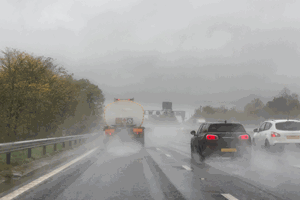
B
C
D
E
Correct Answer: A, C
Explanation: The usual two second time gap will increase to four seconds when the roads are wet. If you stay well back you will
- be able to see past the vehicle,
- be out of the spray thrown up by the lorry's tyres,
- give yourself more time to stop if the need arises,
- increase your chances of being seen by the lorry driver.
Explanation: The usual two second time gap will increase to four seconds when the roads are wet. If you stay well back you will
- be able to see past the vehicle,
- be out of the spray thrown up by the lorry's tyres,
- give yourself more time to stop if the need arises,
- increase your chances of being seen by the lorry driver.
Correct Answer: D
Explanation: You MUST turn off your fog lights if visibility is over 100 metres (328 feet). However, be prepared for the fact that the fog may be patchy.
Explanation: You MUST turn off your fog lights if visibility is over 100 metres (328 feet). However, be prepared for the fact that the fog may be patchy.
46. Your car requires an MOT certificate. When is it legal to drive it without an MOT certificate?
Mark one answer
B
C
D
Correct Answer: D
Explanation: When a car is three years old (four years old in Northern Ireland), it MUST pass an MOT test and have a valid MOT certificate before it can be used on the road. Exceptionally, you may
- drive to a pre-arranged test appointment or to a garage for repairs required for the test,
- drive vehicles made before 1960 without an MOT test, but they must be in a roadworthy condition before being used on the road.
Explanation: When a car is three years old (four years old in Northern Ireland), it MUST pass an MOT test and have a valid MOT certificate before it can be used on the road. Exceptionally, you may
- drive to a pre-arranged test appointment or to a garage for repairs required for the test,
- drive vehicles made before 1960 without an MOT test, but they must be in a roadworthy condition before being used on the road.
47. Your vehicle catches fire while driving through a tunnel. It is still driveable. What should you do?
Mark one answer
B
C
D
Correct Answer: A
Explanation: If it's possible, and you can do so without causing further danger, it may be safer to drive a vehicle which is on fire out of a tunnel. The greatest danger in a tunnel fire is smoke and suffocation.
Explanation: If it's possible, and you can do so without causing further danger, it may be safer to drive a vehicle which is on fire out of a tunnel. The greatest danger in a tunnel fire is smoke and suffocation.
48. You are in a tunnel. Your vehicle is on fire and you CANNOT drive it. What should you do?
Mark two answers
B
C
D
E
F
Correct Answer: D, E
Explanation: It's usually better to drive a burning vehicle out of a tunnel. If you can't do this pull over and stop at an emergency point if possible. Switch off the engine, use hazard warning lights, and leave the vehicle immediately. Call for help from the nearest emergency point. If you have an extinguisher it may help to put out a small fire but do NOT try to tackle a large one.
Explanation: It's usually better to drive a burning vehicle out of a tunnel. If you can't do this pull over and stop at an emergency point if possible. Switch off the engine, use hazard warning lights, and leave the vehicle immediately. Call for help from the nearest emergency point. If you have an extinguisher it may help to put out a small fire but do NOT try to tackle a large one.
49. New drivers can take further training after passing the practical test. A Pass Plus course will help to
Mark two answers
B
C
D
Correct Answer: B, D
Explanation: Novice drivers are in much more danger than experienced drivers. They can often be involved in collisions soon after passing their test, sometimes with tragic results. The Pass Plus scheme gives structured training to help new drivers improve basic skills and widen their experience. Approved Driving Instructors (ADIs) will be able to advise of the benefits.
Explanation: Novice drivers are in much more danger than experienced drivers. They can often be involved in collisions soon after passing their test, sometimes with tragic results. The Pass Plus scheme gives structured training to help new drivers improve basic skills and widen their experience. Approved Driving Instructors (ADIs) will be able to advise of the benefits.
Correct Answer: D
Explanation: Be aware that other traffic might still be clearing the junction. Make sure the way is clear before continuing.
Explanation: Be aware that other traffic might still be clearing the junction. Make sure the way is clear before continuing.



